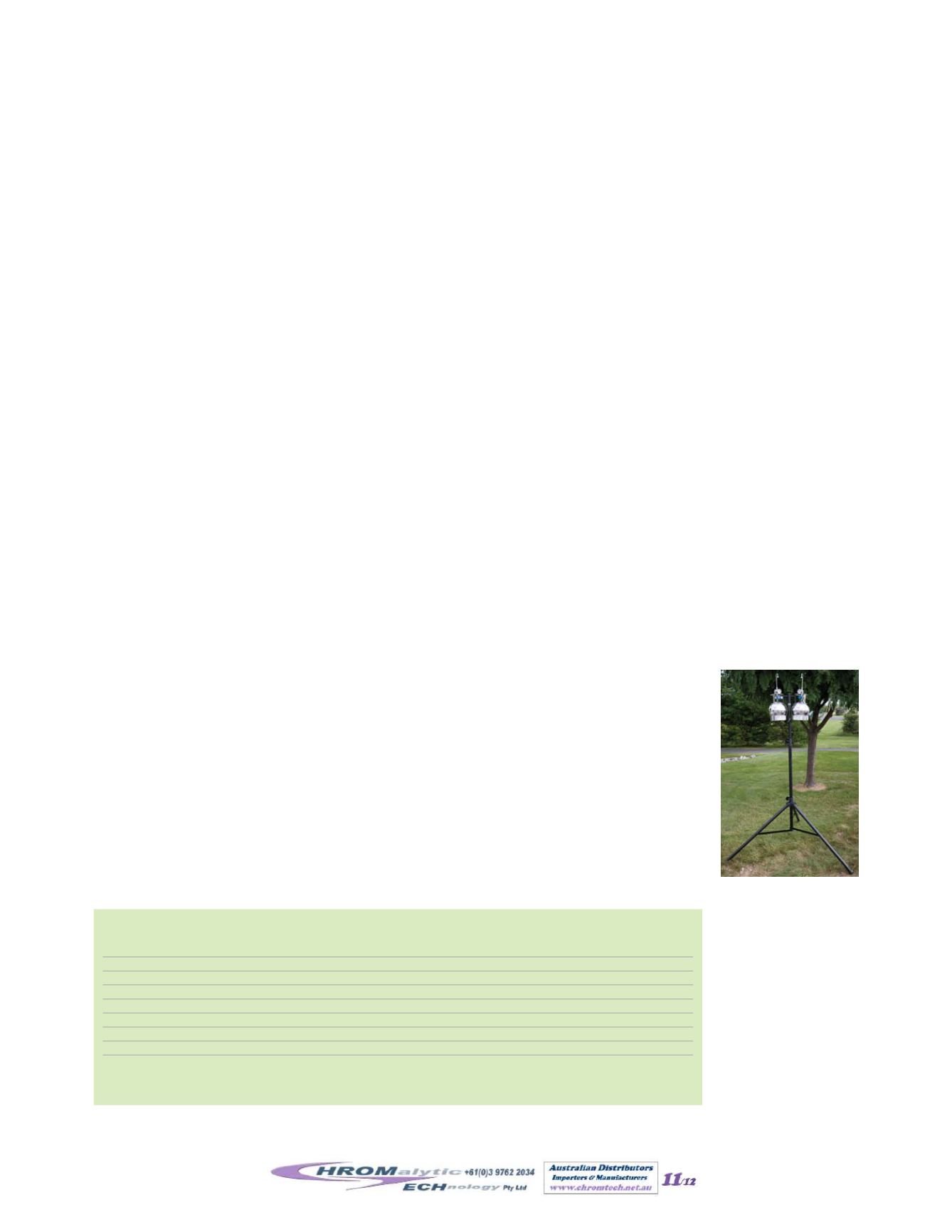
7
800-356-1688
•
IV.Preparing theCanister forSampling
Preparing a canister for sampling involves certifying the canister clean, evacuating the canister to final
pressure for use, and identifying the canister. All information acquired during these processes is needed
for the chainof custody.
Certifying thecleanlinessof thecanister is important towardensuring that results reportedare solely from
the site sampled, andnot contaminatedwith residue from aprevious siteor volatiles in laboratory air.To
certifyacanisterclean, fill thecanisterwithhumidifiedair,pass theair from thecanister throughanadsor-
bent trap and analyze the adsorbent for targetVOCs byGC/MS or other selective detector. TwoUSEPA
methodsdiscuss canistercertification:EPACompendiumTO-12andEPACompendiumTO-14A/TO-15.
To comply with EPA CompendiumMethods TO-14A/TO-15, the analytical system should not detect
greater than0.2ppbvof any targetVOC.To complywithEPACompendiumMethodTO-12 the analyti-
cal system,GC/FID, shouldnotdetectgreater than0.02ppmChydrocarbons.Althoughbatchcertification
of canister cleanliness is a relatively common practice, we recommend certifying and documenting each
canister individually. Detailed cleaning instructions are presented in SectionVIII. Cleaning the Canister
(page 11).
Some laboratories certifyacanister forVOC stabilityby introducinga lowconcentration testmixture into
the canister andmeasuring degradation over a specified time period. If the canistermeets the specifica-
tion, it is certified for use.We recommend using such studies to ensure the effectiveness of a canister or
groupof canisters for aproposed application.
Once thecanister is certifiedclean, evacuate thecanister toa final vacuumof 10-50mtorr,usingeither the
canister cleaning system or a clean final vacuum system. This vacuum is critical to ensure the correct
amount of sample is collected.Use an accurate test gauge (shown inFigure 7b, page 4) or digital pressure
tester to ensure final vacuumhas been reached and todocument the final vacuum reading for the chain
of custody. Install a brass capnut onto the canister valve to ensure no contamination can enter the sam-
ple pathwayduring shipment to the field.
Apply an individual identity to the canister, eitherwith a label and serial number orwith a bar code.
Some analysts prefer to introduce surrogate standards into the canister prior to sampling.Debate on this
practice revolves around theories that there are potential loss issues due to lowhumidity and inadequate
surfacepassivationbywater.NeitherRestek chemistsnor our consulting experts recommend adding sur-
rogates to thecanisters. If youchoose to introduce surrogates intoyourcanistersprior to sampling,be sure
to recheck and record the vacuum reading for each canister after adding the surrogates.
V. FieldSampling,UsingaPassiveSamplingTrainandCanister
It is important tomention again that the sampling train and canister must be leak tested and certified
cleanprior touse.Toproperlybegin field sampling,we recommendbringing a“practice”evacuated can-
ister anda flowmeasuringdevicewithyou to the field.Use this canister toverify the flow rate through the
passive sampling trainprior tousing the train toobtain samplesof record.Toverify the flow rate, connect
thepassive sampling train to the“practice”canister.Attach a flowmeter to the inlet of the sampling train.
Open the canister andmeasure the flow rate through the sampling train. If the flow rate iswithin±10%
of the flow rate set in the lab, the train is ready tobeusedon the formal sampling canister. If the flow rate
is notwithin these limits, adjust the flow rate by adjusting the piston gap screw.
When the flow rate is confirmed, record the rate as the canister flow rate for the chainof custody form.
didyou
know
?
Our light-weight tripod holds
2 canisters securelywithout
any tools.
PressureConversionTable
Pressure
psi
atm
kg/cm
2
torr
kP
a
bar
inchesHg
psi= 1
0.068
0.0703
51.713
6.8948
0.06895
2.0359
atm=
14.696
1
1.0332
760
101.32
1.0133
29.921
kg/cm
2
= 14.223
0.967
1
735.5
98.06
0.9806
28.958
torr=
0.0193
0.00132
0.00136
1
0.1330
0.00133
0.0394
kP
a
=
0.1450
0.00987
0.0102
7.52
1
0.0100
0.2962
bar=
14.5038
0.9869
1.0197
751.88
100
1
29.5300
inHg=
0.49612
0.0334
0.0345
25.400
3.376
0.03376
1
Multiply units in the left-most columnby the conversion factors listed in the columns to the right.
e.g., 10PSI x 0.068= 0.68atm, 10 bar x 29.5300= 295.300 inches Hg
Website :
E-mail :
TelNo : 03 9762 2034 . . . inAUSTRALIA


